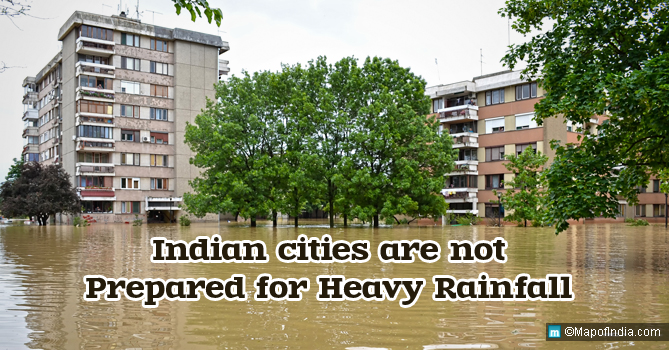Yesterday Mumbai, the financial capital of our country, experienced over 200 mm of rainfall. This is more rain than what the city would receive in over 10 days during regular monsoons. All in a matter of 12 hours, the rain gods managed to bring India’s most bustling and industrious city to its knees. 5 Mumbaikars died, homes and offices were flooded, train services paralysed, and most office goers stranded far from home. The National Disaster Response Force (NDRF) had to be called in to rescue people from rising water levels.
This morning, news reports screamed “unexpected rainfall”. Some blamed freak weather conditions while other quite predictably blamed the municipal corporation and politicians for their lack of involvement in urban planning. Let us take a look if this is an isolated incident. About 10 days ago, on 21 August, 2017, the capital of Haryana and Punjab received a record rainfall of about 112 mm. This was said to be some 23 times the average rainfall received by the city on a monsoon day. India’s best planned city, one of the cleanest cities in the country as well, was largely inundated.
Just about a few days ago, on 15 August, Bengaluru the IT capital received record breaking rains (over 129 mm) in a span of 24 hours – another “unexpected” rainfall that pulled the brakes on one of the country’s largest cities. Many parts of the city were inundated and vehicles were found floating in the waters. Going back a couple of years, the memories of Chennai floods in 2015, the massive destruction to life and property, and the large-scale rescue work are still fresh in our minds.
This brings us to the all-important question – When will we start expecting these “unexpected rains” and prepare our cities to deal with such weather conditions?
Poor Urban Planning
Most of India’s cities, particularly the larger metropolitan areas suffer from very poor planning. These cities have developed naturally without the benefit of planned drainage and waste management systems. From time to time repair work has been undertaken by the corporations – themselves riddled with poor resources, lack of funding, political frustrations, and other such struggles – but almost none of the cities have benefited from structured planning and engineering efforts. The drains used to remove rain water are often the same that carry sewage away from the cities. This makes recycling of rainwater, prevention of floods, and quick removal of flood waters impossible. In some cities, such as Chennai, there are storm water drains but these were constructed without any proper understanding of the rain and flooding patterns in the city.
Lack of effective garbage disposal systems must also be looked at. The compounding effect of plastic usage has led to clogged rainwater disposal systems and drains. Add to this the fact that most of our major cities have completely redone by removal of green spaces. Concrete, tar, and tarmac prevent any absorption of rainwater into the ground, causing more floods and lowering groundwater levels around urban areas.
Poor Ability To Predict Heavy Rainfall
Apart from poor urban planning one of the major causes for such large scale natural disasters in the urban regions of our country and for the suffering of the hundreds and thousands of people who live in these cities is the inability to accurately predict heavy rainfall. Incidences of extreme rainfall are becoming more frequent in the cities of India and the India Meteorological Department is quite ill equipped to foresee such occurrences. There are times when countries such as the US are also unable to predict the onset of hurricanes and other similar weather phenomena but these countries and their administrations have put in place emergency response systems and have created an awareness protocols which allows citizens to cope with such natural disasters.
Climate Change And Extreme Rainfall
While we all acknowledge that our cities are extremely vulnerable to extreme rainfall, we fail to recognize our own roles in precipitating these natural disasters. Rampant deforestation and lack of green covers have turned our cities into urban deserts. These unprecedented rains and floods are all ultimately manmade disasters. It is not too late but may be in a few years from now. Reducing use of plastics, maintaining a healthy ratio between concrete construction and green cover is imperative. What is more important is to teach the future generations the value of preserving the environment and planting more trees.





